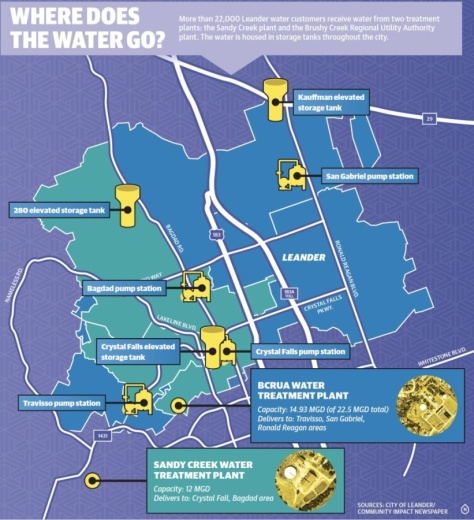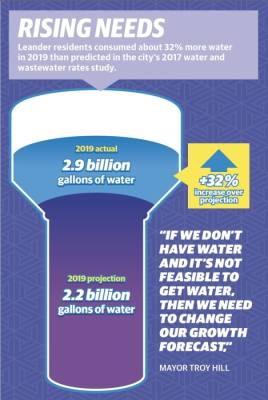Recent water restrictions, a long list of future water projects and a lack of long-term water data have raised questions about the sustainability of Leander’s water demand, city officials said.
The city has more than doubled its population in 10 years, according to census data. Leander Mayor Troy Hill said water or wastewater studies are not required or considered when approving new developments. So with thousands of new apartments, new schools, and a mixed-use development under construction, the city is seeking how to securely supply water to its growing residents.
Leander has enough water for its more than 22,000 customers, but the concern is the overwhelmed delivery system, Hill said.
“I don’t think there was proper modeling done by our previous staff, and I would even say that would be true of our current staff,” Hill said.
High rates, new issues
In July, Leander residents saw what a water shortage could be like. The city upped water restrictions to Stage 3 and called for a six-day boil water notice after a power outage at the city-owned Sandy Creek Water Treatment Plant on July 18.
The city does not have a water shortage, but peak water demand caused by increased time spent at home, high temperatures and a power outage created an issue the city had not faced before, according to Mike Neu, the city spokesperson.
Todd Haas, a Leander resident, said the boil water notice, which affected his home, led to concerns and questions about the city’s water system and longevity. Before moving to the city about 2 1/2 years ago, he never thought to question where the water comes from or about water costs. The answers were surprising to Haas and his wife.
“That’s when you find out there is no backup generator at the main plant,” he said.
Despite upcoming and in-progress projects to help water issues, watching more apartments and houses build up around the city is not reassuring, Haas said. He moved from Cedar Park to Leander, and the short move resulted in double the cost on his water bill. He said he now pays about $120 per month.
“I’m paying double what I was two years ago; alright, I got over that. But now, to find out that it is not really doing anything—I don’t feel secure in the water strategy,” Haas said.
Hill said the city does not have the redundancy to fulfill the city’s water needs.
Redundancy in pipelines serves as a backup to the existing pipelines. The San Gabriel Parkway Phase 1 water mains project will add “redundancy and reliability in water transmission during emergency conditions,” according to the city.
Hill said the city also did not have a backup generator during the outage, which the city is exploring options for. However, the water redundancy would be the ideal, long-term solution for the city, Hill said.
Leander Public Works Director Gina Ellison said the July events were caused by customers’ high demand, which reduced the time that water storage facilities need to recover water for the next day.
“Leander’s water system infrastructure simply could not treat and distribute enough pressurized water day after day to meet the city’s peak summer demands,” Ellison said.
City officials lowered water restrictions to Stage 2 on Sept. 21 following reduced demand and lower temperatures.
In July, Leander residents were using an average of 14 million gallons per day, or MGD. As of Sept. 15, the city used 10 MGD. The city’s total existing water treatment capacity is 26.9 MGD. This is enough to supply the city, but the city said the Sandy Creek plant comes closer to its maximum capacity each year.
The Sandy Creek plant is one of two water sources for the city. Sandy Creek supplied about 60% of the city water this summer, and the Brushy Creek Regional Utility Authority plant supplied about 40%. Ellison said the city is opening a new pipeline between the two plants in September to move more BCRUA water through Sandy Creek lines into the city.
In 2007, the cities of Cedar Park, Leander and Round Rock formed the BCRUA. The trio fund the water treatment plant and phased construction. All three BCRUA cities have additional water sources, though Leander funds the most of the three cities, according to city officials.
The city’s water supply and treatment capacity is sufficient for existing water customers, according to the city. But to handle growth, Leander is looking to transfer additional water treatment to the BCRUA plant for more efficient distribution.
Hill said recent issues illustrated how the city has not worked to model how growth would affect its water system.
“If we don’t have water and it’s not feasible to get water, then we need to change our growth forecast, and we need to pump the brakes on growth a little bit,” Hill said.
Leander has the second-highest water rates in Central Texas after Hutto when compared to nearby cities, according to a Leander survey. The average water bill was $80.63, according to 2019 city data, compared to $39.55 in Cedar Park, $29.50 in Georgetown and $37 in Round Rock.
The high cost is from Leander’s water plant bonds. Hill said there is no solution to bring rates down until long-term debt from infrastructure projects is paid off, which is not expected in the near future.
“Everyone should pay for the amount of water that they’re using. But quite frankly, we took on the cost of building 48% of that plant. Looking back on it, that was foolish,” Hill said.
Need for water data
Leander is waiting for the results of its first-ever long-range water study.
The study, approved Aug. 6 in a $359,837 contract with Black & Veatch, will determine the most cost-effective methods of reliable water supply for Leander’s full build-out.
Council Member Christine Sederquist said the city critically needs a third-party consultant to look at the city’s water situation. Results are expected in early 2021, and until then she said she feels “in limbo.”
“If you had asked me eight months ago, I would have said ‘Everything was fantastic, and we have nothing to worry about,’’’ she said.
While traffic and transportation studies are often required on large developments, Hill said water use is not considered or presented to the council before past approvals of residential or commercial development.
According to Hill, the city should have requested water and wastewater impact studies before developments were approved. This is something he will look at, and he hopes the council will look at, moving forward, he said.
“I think it’s got to be part of our thinking, and I think it will from now on. It will as long as I’m mayor,” he said.
Hill and Council Member Jason Shaw said the study results will confirm that the future $80 million deep-water intake project is the right choice for the city.
“We’re not going to do it because someone conducted a study in 2005 from another city and said that is what’s best for Leander. We’re not going to do that,” Shaw said. “We’re going to make sure that the data says this is the best thing to do.”
Shaw said the city caught the issues “before a disaster happened.”
Partnered solutions
Based on current infrastructure, Leander will exceed its BCRUA water capacity in 2026 without alternative water sources or without joint efforts with neighboring cities.
In October, BCRUA will complete the $17 million construction of Phase 1C to expand Leander’s water capacity from 10.55 to 14.93 MGD—a 41.52% increase. This phase is expected to supply water through 2028, BCRUA General Manager Karen Bondy said. These capacities are equal to how much water is used.
If the Phase 2 plan comes online in 2027 as projected, Leander will need to make up about 1.28 MGD in difference in water demand versus water supply capacity. Without Phase 2A, Leander would exceed its demand in 2026. The Phase 2A construction, which will begin in 2022, builds a deep-water intake to move untreated water from Lake Travis to the BCRUA plant,
Bondy said. The permanent water intake replaces the temporary intake built in Phase 1.
Bondy said while the city may see a deficit in water capacity, there are solutions such as interlocal agreements.
“With the partnership, then the cities can work among themselves to share water,” she said.
In 2027, Cedar Park will have a 1.58 MGD surplus for its peak day demand, and Round Rock’s peak day will have a 0.56 MGD surplus. Both surpluses could potentially supply Leander’s deficit, she said.
BCRUA plant expansions and phases are based on cities’ water demands that they provide to BCRUA, Bondy said.
Hill said the city is currently looking at additional water sources or reservoirs. No plans are confirmed yet, but they could include different sources or deals with other cities.
Shaw, who represents Leander on the BCRUA board, said he wants to look at a secondary water source aside from Lake Travis, which supplies both plants.
He said the BCRUA deal was appealing at the time of approval because the city was in need of water.
In approving future development, Shaw said growth cannot outpace water. Shaw said he does not blame previous councils for the issues, and today’s council only knows of the water problems because of recent issues.
“If we’re building and we out-build our water, that doesn’t make any sense at all,” Shaw said. “I’m not saying we’re there, but we could get there very quickly.”








